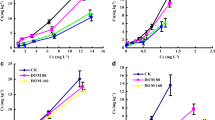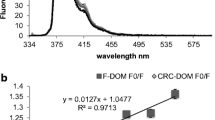Abstract
This study was focused on the effect of the presence of surfactant on the bioremediation efficacy and sensitivity of solid phase microextraction (SPME) in the pyrene-contaminated soil. Soils with 1.3 and 7.6% soil organic matter (SOM) were tested for biodegradation by microorganisms and extracted by aqueous solutions of the matrix used for SPME. For the biodegradation test, the presence of Triton X-100 at 5× CMC (critical micelle concentration) significantly enhanced pyrene removal for soil with lower SOM content (1.3%). However, this removal was insignificant for soil with higher SOM content (7.6%). The results may suggest that 5× CMC was not sufficient to improve significantly pyrene desorption for soil with higher SOM content. For the bioavailability test, in the absence of Triton X-100, SPME estimation of bioavailability in soils with indigenous or seeded microorganisms had an error range within 15%. However, with addition of Triton X-100, SPME estimations showed a significant decline (41 and 77%), in relation to their predicted values, for soil samples with SOM of 1.3 and 7.6%, respectively. The main reason for this underestimation is that micelle formation from the application of surfactant impacted the concentration of dissolved pyrene, rather than competitive site occupation between pyrene and surfactant molecules for SPME fiber. Thus, if soil samples contain surfactant, SPME would significantly underestimate bioavailability and risk level of PAH-contaminated sites.



Similar content being viewed by others
References
Bergknut M, Sehlin E, Lundstedt S, Andersson PL, Haglund P, Tysklind M (2007) Comparison of techniques for estimating PAH bioavailability: uptake in Eisenia fetida, passive samplers and leaching using various solvents and additives. Environ Pollut 145:154–160
Bonten LTC (2001) Improving bioremediation of PAH contaminated soils by thermal pretreatment. PhD Thesis, Wageningen University, The Netherlands
Bramwell DP, Laha S (2000) Effects of surfactant addition on the biomineralization and microbial toxicity of phenanthrene. Biodegradation 11:263–277
Cheng KY, Wong JW (2006) Effect of synthetic surfactants on the solubilization and distribution of PAHs in water/soil–water systems. Environ Technol 27:835–844
Chung N, Alexander M (1998) Differences in sequestration and bioavailability of organic compounds aged in dissimilar soils. Environ Sci Technol 32:855–860
Chung N, Alexander M (1999) Effect of concentration on sequestration and bioavailability of two polycyclic aromatic hydrocarbons. Environ Sci Technol 33:3605–3608
Cuny P, Faucet J, Acquaviva M, Bertrand JC, Gilewicz M (1999) Enhanced biodegradation of phenanthrene by a marine bacterium in presence of a synthetic surfactant. Lett Appl Microbiol 29:242–245
Cuypers C, Pancras T, Grotenhuis T, Rulkens W (2002) The estimation of PAH bioavailability in contaminated sediments using hydroxypropyl-beta-cyclodextrin and Triton X-100 extraction techniques. Chemosphere 46:1235–1245
Hamelink JL, Landrum PF, Bergman HL, Benson WH (1994) Bioavailability: physical, chemical and biological interactions. Lewis Publishers, Chelsea, Michigan, pp 239–254
Kelsey JW, Kottler BD, Alexander M (1996) Selective chemical extractants to predict bioavailability of soil-aged organic chemicals. Environ Sci Technol 31:214–217
Lei L, Suidan MT, Khodadoust AP, Tabak HH (2004) Assessing the bioavailability of PAHs in field-contaminated sediment using XAD-2 assisted desorption. Environ Sci Technol 38:1786–1793
Liu HC, Hwu CS, Chu KC, Lu CJ (2010) Estimation of bioavailability and potential risks of naphthalene in soils with solid phase micro extraction. World J Microbiol Biotechnol 26(7):1311–1316
Miller ME, Alexander M (1991) Kinetics of bacterial degradation of benzylamine in a montmorillonite suspension. Environ Sci Technol 25:240–245
Nam K, Chung N, Alexander M (1998) Relationship between organic matter content of soil and the sequestration of phenanthrene. Environ Sci Technol 32:3785–3788
Reid BJ, Stokes JD, Jones KC, Semple KT (2000) Nonexhaustive cyclodextrin-based extraction technique for the evaluation of PAH bioavailability. Environ Sci Technol 34:3174–3179
Tang J, Petersen EJ, Huang Q, Weber WJ (2007) Development of engineered natural organic sorbents for environmental applications: 3. Reducing PAH mobility and bioavailability in contaminated soil and sediment systems. Environ Sci Technol 41:2901–2907
Tang J, Petersen EJ, Weber WJ (2008) Development of engineered natural organic sorbents for environmental applications: 4. effects on biodegradation and distribution of pyrene in soils. Environ Sci Technol 42:1283–1289
Trimble TA, You J, Lydy MJ (2008) Bioavailability of PCBs from field-collected sediments: application of Tenax extraction and matrix-SPME techniques. Chemosphere 71:337–344
Van der Wal L, van Gestel CA, Hermens JL (2004a) Solid phase microextraction as a tool to predict internal concentrations of soil contaminants in terrestrial organisms after exposure to a laboratory standard soil. Chemosphere 54:561–568
Van der Wal L, Jager T, Fleuren RH, Barendregt A, Sinnige TL, van Gestel CA, Hermens JL (2004b) Solid-phase micro extraction to predict bioavailability and accumulation of organic micropollutants in terrestrial organisms after exposure to a field-contaminated soil. Environ Sci Technol 38:4842–4848
You J, Landrum PF, Trimble TA, Lydy MJ (2007) Availability of polychlorinated biphenyls in field-contaminated sediment. Environ Toxicol Chem 26:1940–1948
Acknowledgments
Authors are grateful to the National Science Council of Taiwan, for financially supporting this research under Contract no. NSC 98-2221-E-241-007.
Author information
Authors and Affiliations
Corresponding author
Rights and permissions
About this article
Cite this article
Liu, HC., Hwu, CS. & Lu, CJ. Effect of surfactant on the estimation by solid phase microextraction of bioavailable pyrene in soil samples. World J Microbiol Biotechnol 27, 1071–1076 (2011). https://doi.org/10.1007/s11274-010-0552-y
Received:
Accepted:
Published:
Issue Date:
DOI: https://doi.org/10.1007/s11274-010-0552-y




